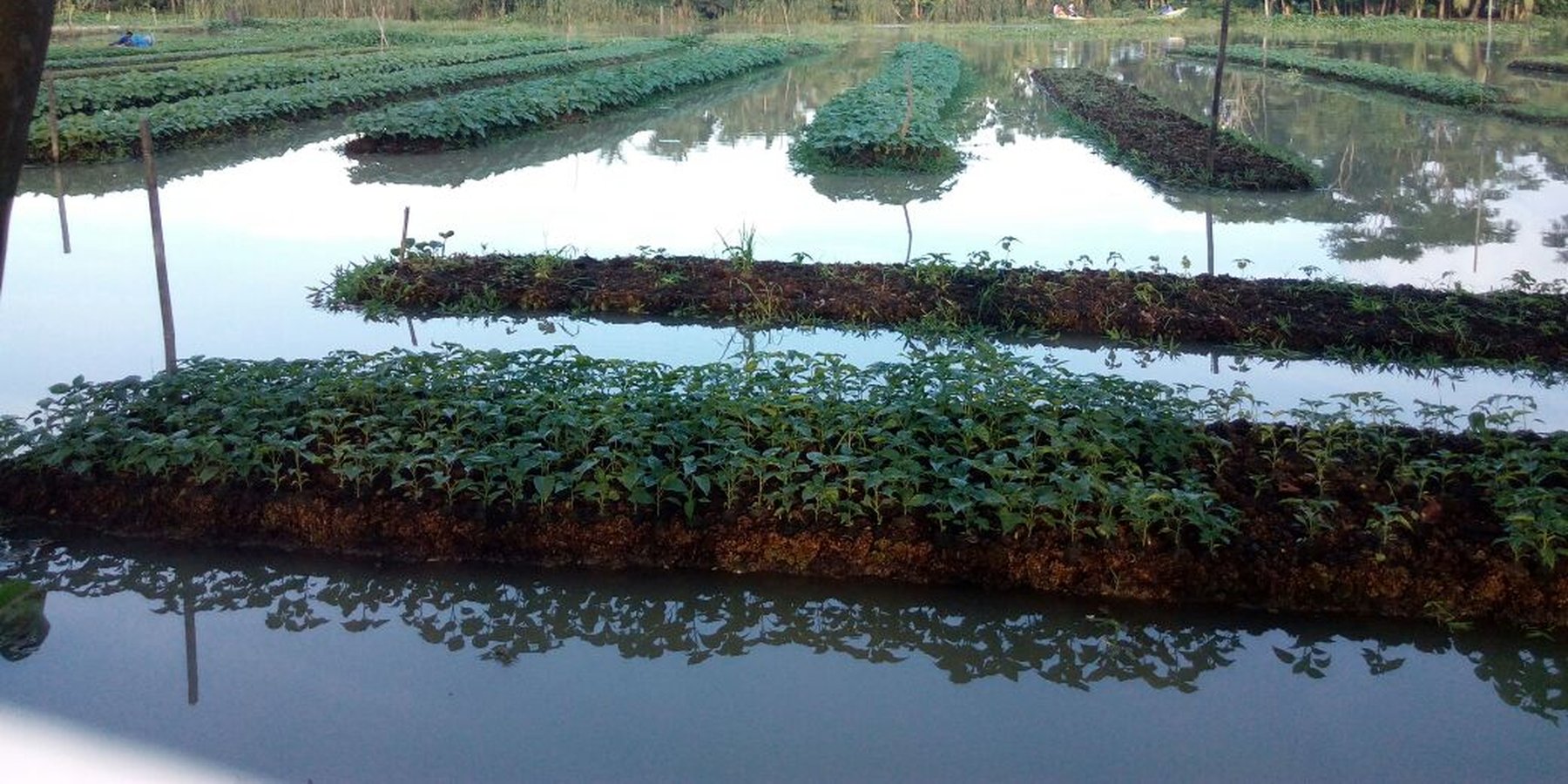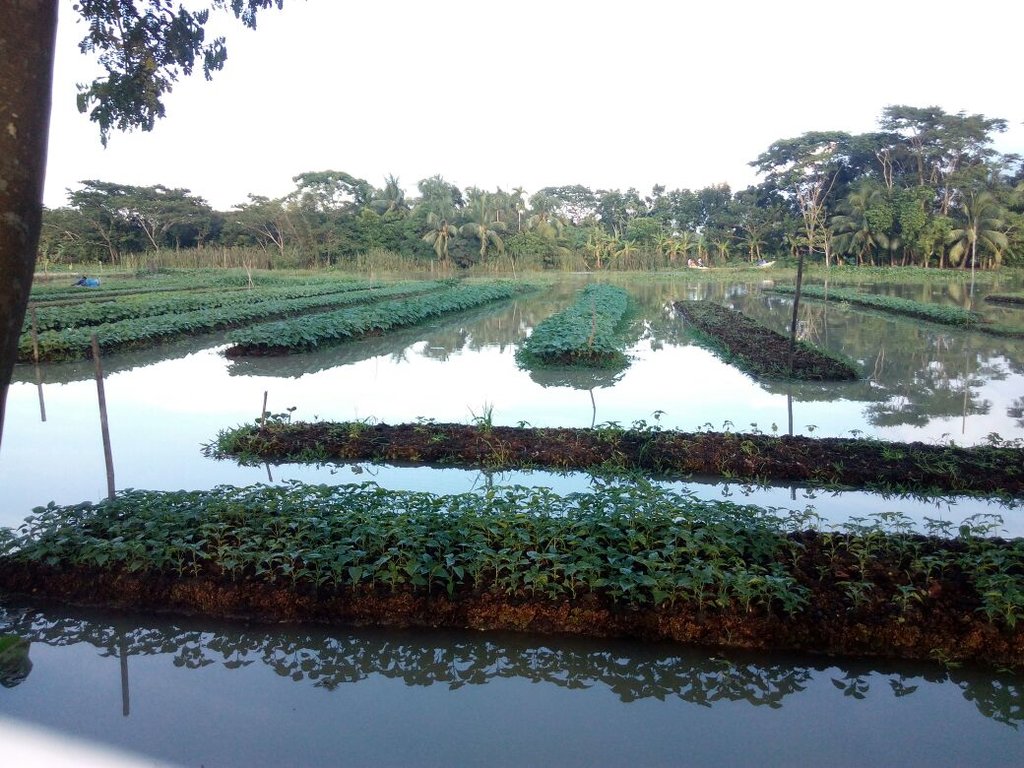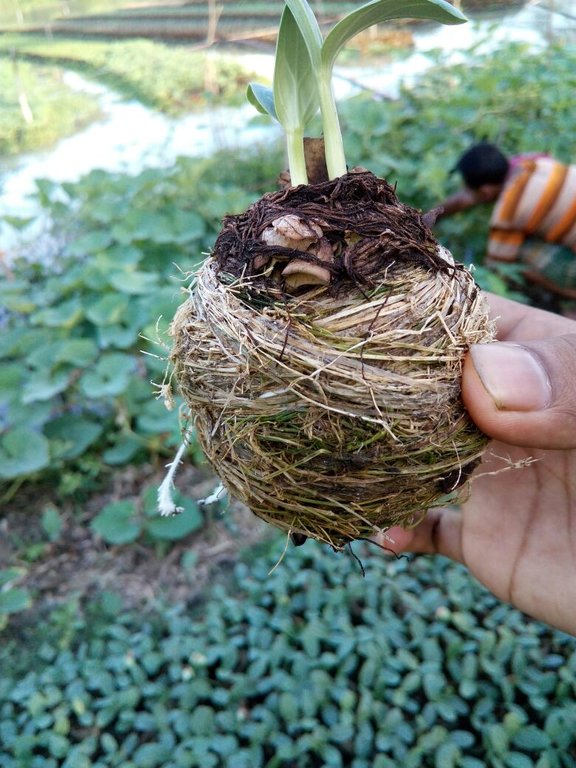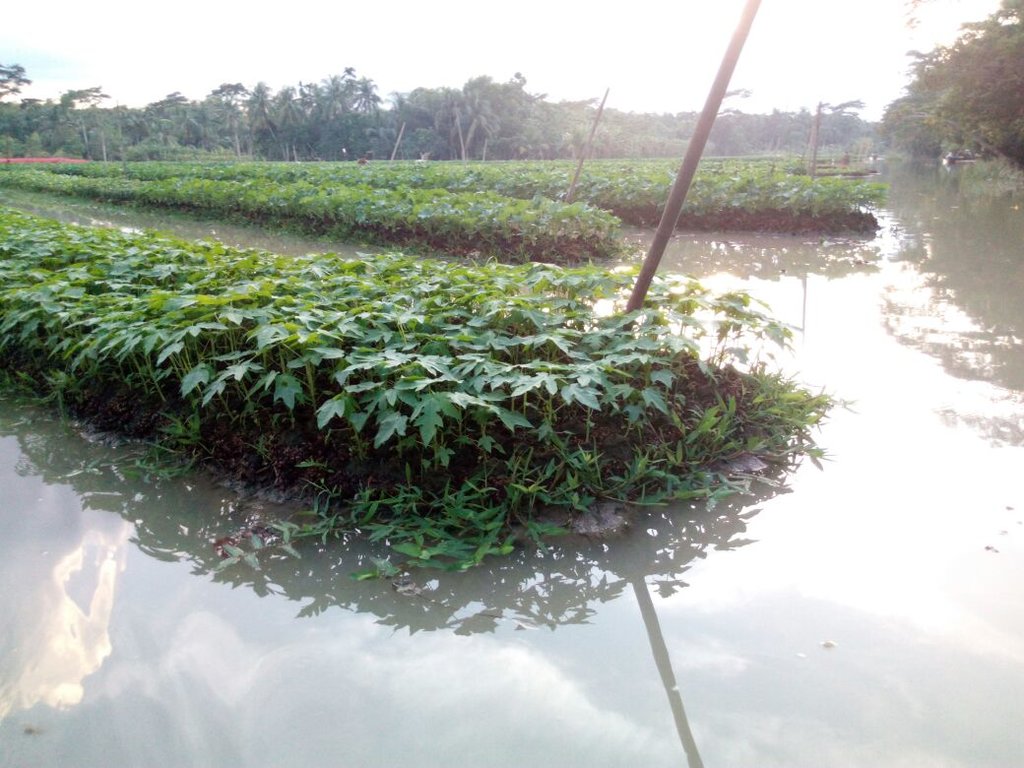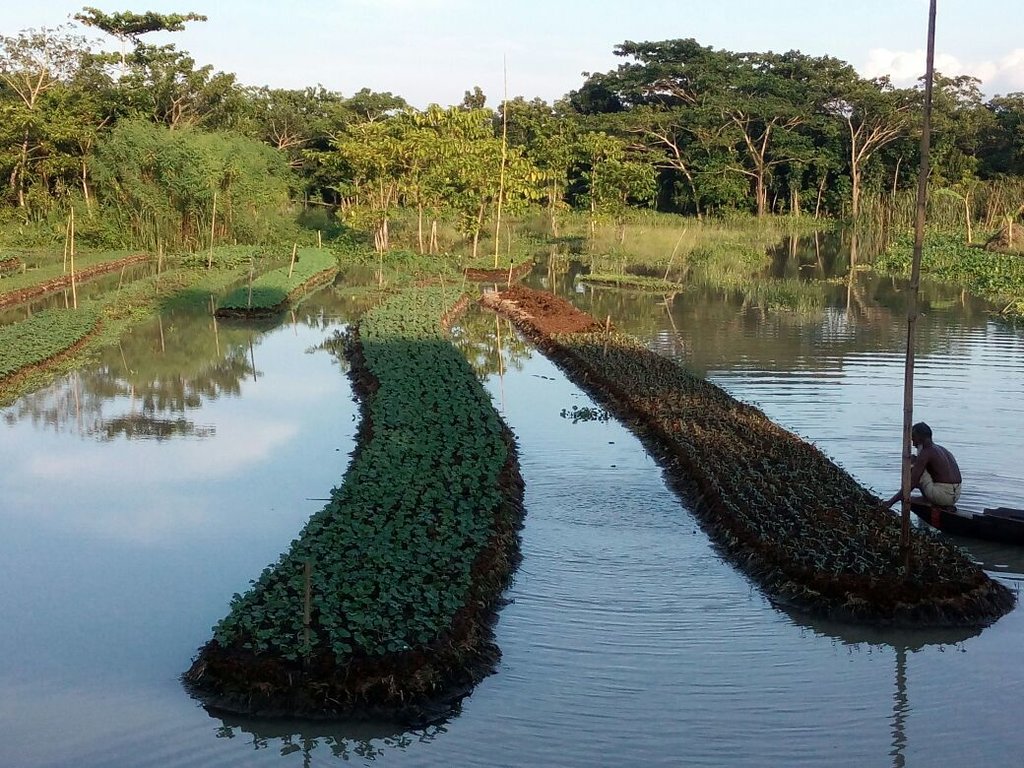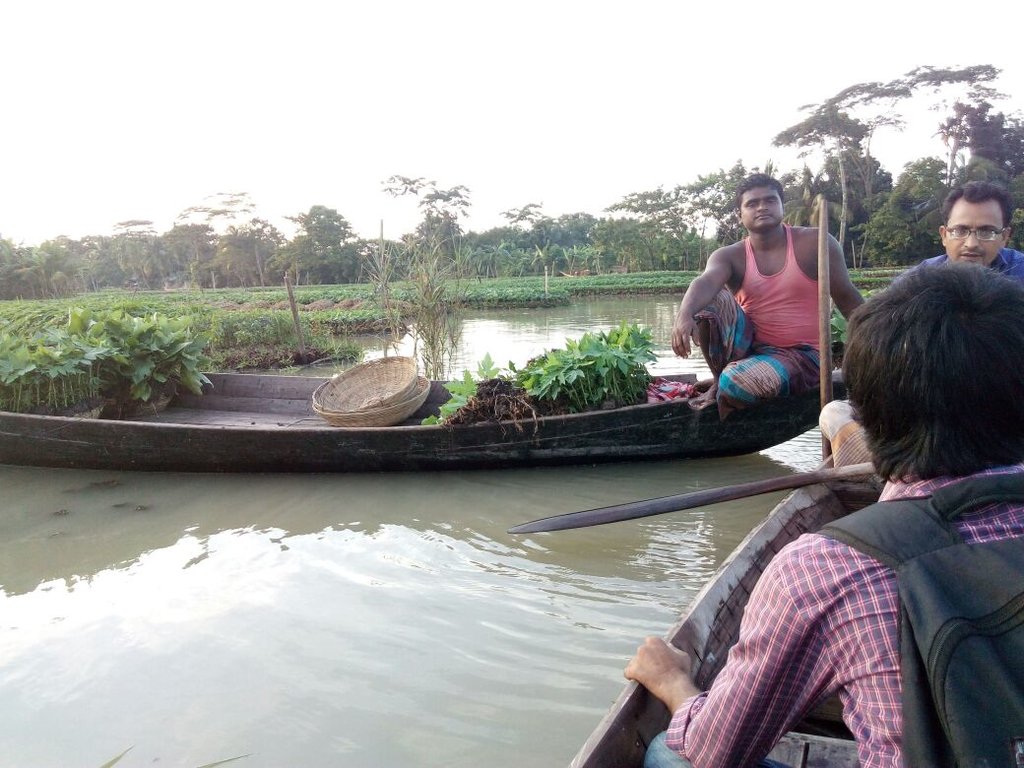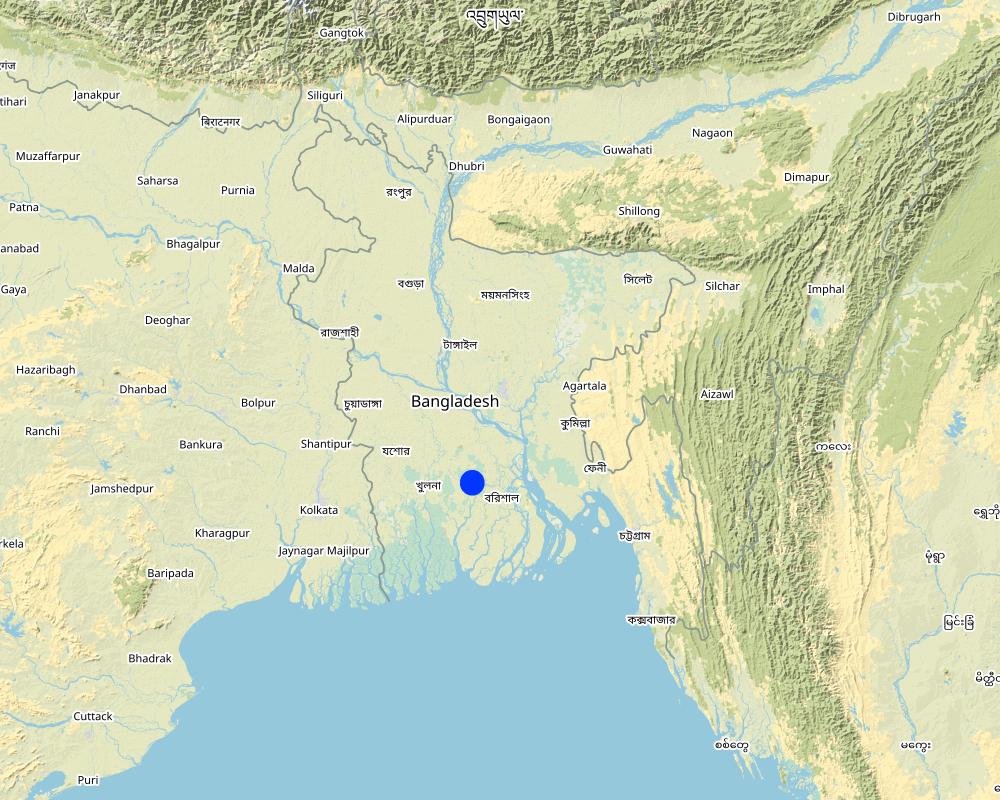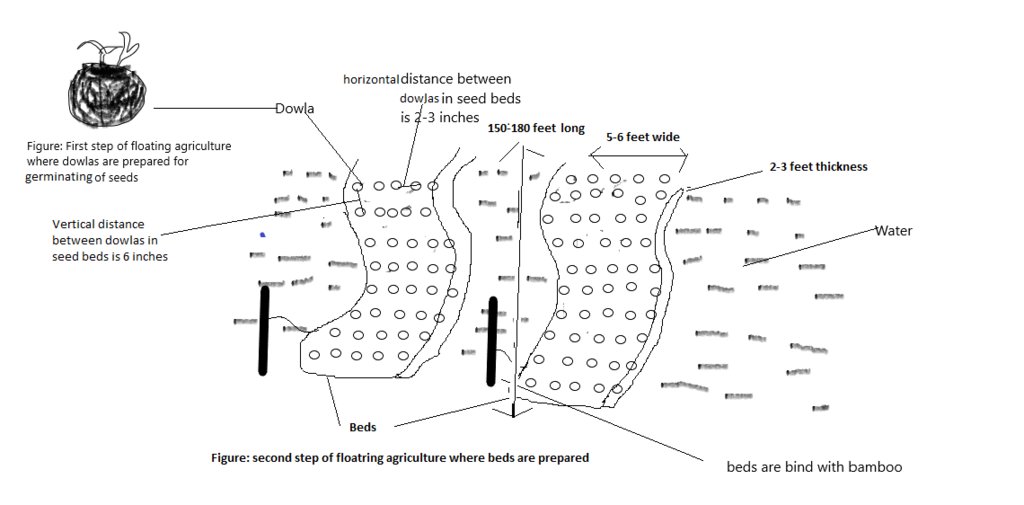FLOATING AGRICULTURE IN WATERLOGGED SOIL [Bangladesh]
- Creation:
- Update:
- Compiler: Naznin Imrana
- Editor: –
- Reviewers: Udo Höggel, Rima Mekdaschi Studer
"Dhap poddhoti"
technologies_3619 - Bangladesh
View sections
Expand all Collapse all1. General information
1.2 Contact details of resource persons and institutions involved in the assessment and documentation of the Technology
Key resource person(s)
Student in Soil and Environment dept. in University of Barisal:
Name of the institution(s) which facilitated the documentation/ evaluation of the Technology (if relevant)
University (of Barisal) - Bangladesh1.3 Conditions regarding the use of data documented through WOCAT
When were the data compiled (in the field)?
07/04/2017
The compiler and key resource person(s) accept the conditions regarding the use of data documented through WOCAT:
Yes
1.4 Declaration on sustainability of the described Technology
Is the Technology described here problematic with regard to land degradation, so that it cannot be declared a sustainable land management technology?
No
2. Description of the SLM Technology
2.1 Short description of the Technology
Definition of the Technology:
The aim of this technology is to use the waterlogged soils, which remain under water during 6 to 7 months of a year, for vegetable seedlings. This is done through floating seed beds which are made of water hyacinths.
2.2 Detailed description of the Technology
Description:
Floating agriculture is a special technique to cultivate vegetables and vegetable seedlings such as Pumpkin, Bean, Brinjal, Cucumber, Tomato, Papaya, Green Chili etc. on waterlogged soils. This is done by using floating seed beds, which are made of water hyacinths and other aquatic plants such as Dulalilata (Hygroryza aristata) Tepapana (Pistia stratiotes) and Khudepana (Lemna spirodela).
Paddy cultivation is usually done from October to April. After the paddy harvest, the lands usually remain waterlogged under 7 to 8 feet of water from May to November. With the onset of the rainy season, these regions are covered with water hyacinths and other aquatic plants etc. Normal agricultural production during this period is not possible due to this waterlogged condition and the growing water hyacinths, Dulalilata, Tepapana etc.
However, floating agriculture enables farmers to use this land in the best productive way. Floating agriculture is started by collecting water plants (Hyacinth, Dulalilata, Tepapana) for preparing floating seedbeds using these plants. This is because the vegetable seeds cannot be sown traditionally into the soil. Hence, a nutritious soft ball is prepared by using Tepapana and Khudepana which is called dowla. A small amount of urea fertilizer is put into each dowla. Thereafter, different types of vegetable seeds are sown / placed, in wet condition, into the dowlas. The dowlas so prepared are kept in an open place for drying / sprouting for 3 to 7 days. Thereafter, the dowlas are placed on the floating seedbed, which have been already made, where each Dowla is placed respecting 6 inches of distance in a bed. In such manner and about 2,450 dowlas can be placed in each seedbed. After taking proper care for one month including irrigation every day to prevent root dry up and fertilisation using a little amount urea fertilizer the sprouting seedlings are getting matured and ready for sale.
The establishment costs for a floating seedbed of 150 -180 feet long is between 3000 to 5500 taka. To make such a floating seedbed, a person must work 6 to 8 or 10 hours on a wage of 250 taka per workday. Nearly 25000 thousand women workers of these regions are directly or indirectly involved in this production. Each worker earns 200 to 250 taka per day. On an average, women can prepare between 1000 to 2000 dowlas per day. In this work, a female worker gets an average of 150 to 200 taka per day. A farmer earns 6-7 thousand taka through one time use of bed by selling seedlings within 20-22 days. The seedbeds can be used at least 3 times for seedling production in a season (May to November). So, it is possible to earn 18000 -20000 taka per bed in a season.
After that, the floating beds can be used again for growing vegetables, thus they are able to grow about ten thousand metric tons of vegetables annually in these regions that meets the local demand. Some vegetables are also sent to other regions /communities, achieving a very beneficial profit. It is possible to earn about 2-3 thousand taka by selling vegetables. After completing all these seedlings and vegetables growing processes seedbeds can be sold for between 1-2 thousand taka to other farmers. Therefore, it is possible to earn 20000-250000 taka per bed in a season including all other sources of income, which are mentioned above.
Storm and other climatic hazards cannot do much harm to this cultivation method. Besides, it is possible to produce vegetables throughout the year.
Using this technology allows people of waterlogged regions to turn their wheel of fortune by cultivating vegetables/vegetable seedlings, hence being able to overcome poverty up to 70%.
2.3 Photos of the Technology
2.5 Country/ region/ locations where the Technology has been applied and which are covered by this assessment
Country:
Bangladesh
Region/ State/ Province:
Nazirpur Upazila (upazila means sub unit of a district), Pirojpur District
Further specification of location:
Gaokhali,Mugarjhor,Bisharkandi,Bildumoria etc
Map
×2.6 Date of implementation
If precise year is not known, indicate approximate date:
- more than 50 years ago (traditional)
2.7 Introduction of the Technology
Specify how the Technology was introduced:
- through land users' innovation
3. Classification of the SLM Technology
3.1 Main purpose(s) of the Technology
- improve production
- create beneficial economic impact
- create beneficial social impact
3.2 Current land use type(s) where the Technology is applied
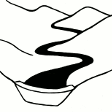
Waterways, waterbodies, wetlands
- waterlogged area
3.3 Further information about land use
Water supply for the land on which the Technology is applied:
- rainfed
Number of growing seasons per year:
- 1
3.4 SLM group to which the Technology belongs
- wetland protection/ management
3.5 Spread of the Technology
Specify the spread of the Technology:
- applied at specific points/ concentrated on a small area
Comments:
This technology is applicable for some specific regions (Banaripara, Agailjhara Ujirpur, Pirojpur’s Nazirpur and Swarupkathi Upazila), as they remain waterlogged from May to October.
3.6 SLM measures comprising the Technology

agronomic measures
- A1: Vegetation/ soil cover
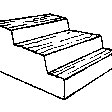
structural measures
- S11: Others
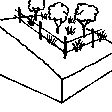
management measures
- M1: Change of land use type
3.8 Prevention, reduction, or restoration of land degradation
Specify the goal of the Technology with regard to land degradation:
- not applicable
4. Technical specifications, implementation activities, inputs, and costs
4.1 Technical drawing of the Technology
4.2 Technical specifications/ explanations of technical drawing
Seed bed and construction material:
-Dimensions: 150 to 180 feet long, 5-6 feet width and thickness 2 to 3 ft.
-Horizontal spacing between structures or plants / vegetative measures (dowlas) : 2-3 inches
-Vertical intervals between structures or vegetative measures: 6 inches
The seedbed consists of floating carpets of water hyacinth, dulalilata (Hygroryza aristata), tepapana (Pistia stratiotes) and other aquatic plants.
Dowla and construction material:
Dowlas are constructed by using tepapana (Pistia stratiotes) and khudepana (Lemna spirodela) water plants that are rolled into a soft ball. The density of dowlas within a seedbed is 2450 seedlings.
4.3 General information regarding the calculation of inputs and costs
Specify how costs and inputs were calculated:
- per Technology area
Indicate size and area unit:
approx. 750 sq feet (70 m2)
If using a local area unit, indicate conversion factor to one hectare:
1 ha = 107639 sq feet
other/ national currency (specify):
Taka
Indicate exchange rate from USD to local currency (if relevant): 1 USD =:
82.7344
Indicate average wage cost of hired labour per day:
250 taka
4.4 Establishment activities
| Activity | Type of measure | Timing | |
|---|---|---|---|
| 1. | Dowla | Agronomic | May to November |
| 2. | Seed bed | Agronomic | May to November |
| 3. | Planting of dowlas into seedbeds | Agronomic | May to November |
4.5 Costs and inputs needed for establishment
| Specify input | Unit | Quantity | Costs per Unit | Total costs per input | % of costs borne by land users | |
|---|---|---|---|---|---|---|
| Labour | Seedbed of 150 to 180 feet long | labour/per bed | 3.0 | 250.0 | 750.0 | 100.0 |
| Labour | Dowla | labour/2450 dowla | 2.0 | 200.0 | 400.0 | 100.0 |
| Plant material | Seed (e.g. pumpkin) | kg | 2.0 | 400.0 | 800.0 | 100.0 |
| Fertilizers and biocides | Urea | kg | 1.0 | 16.0 | 16.0 | 100.0 |
| Construction material | Water hyacinth | ton | 5.0 | 200.0 | 1000.0 | 100.0 |
| Construction material | Dulalilata (Hygroryza aristata) | ton | 2.0 | 500.0 | 1000.0 | 100.0 |
| Construction material | Tepapana (Pistia stratiotes) | ton | 3.0 | 333.0 | 999.0 | 100.0 |
| Construction material | Khudepana (Lemna spirodela) | ton | 0.5 | 1000.0 | 500.0 | 100.0 |
| Total costs for establishment of the Technology | 5465.0 | |||||
4.6 Maintenance/ recurrent activities
| Activity | Type of measure | Timing/ frequency | |
|---|---|---|---|
| 1. | Watch and ward | Management | May to November |
4.7 Costs and inputs needed for maintenance/ recurrent activities (per year)
| Specify input | Unit | Quantity | Costs per Unit | Total costs per input | % of costs borne by land users | |
|---|---|---|---|---|---|---|
| Labour | Watch and ward | per bed | 2.0 | 200.0 | 400.0 | 100.0 |
| Total costs for maintenance of the Technology | 400.0 | |||||
4.8 Most important factors affecting the costs
Describe the most determinate factors affecting the costs:
Labor cost, price of seed and price of urea fertilizer, Dulalilata (Hygroryza aristata), Tepapana (Pistia stratiotes) and Khudepana (Lemna spirodela)
5. Natural and human environment
5.1 Climate
Annual rainfall
- < 250 mm
- 251-500 mm
- 501-750 mm
- 751-1,000 mm
- 1,001-1,500 mm
- 1,501-2,000 mm
- 2,001-3,000 mm
- 3,001-4,000 mm
- > 4,000 mm
Agro-climatic zone
- humid
5.2 Topography
Slopes on average:
- flat (0-2%)
- gentle (3-5%)
- moderate (6-10%)
- rolling (11-15%)
- hilly (16-30%)
- steep (31-60%)
- very steep (>60%)
Landforms:
- plateau/plains
- ridges
- mountain slopes
- hill slopes
- footslopes
- valley floors
Altitudinal zone:
- 0-100 m a.s.l.
- 101-500 m a.s.l.
- 501-1,000 m a.s.l.
- 1,001-1,500 m a.s.l.
- 1,501-2,000 m a.s.l.
- 2,001-2,500 m a.s.l.
- 2,501-3,000 m a.s.l.
- 3,001-4,000 m a.s.l.
- > 4,000 m a.s.l.
Indicate if the Technology is specifically applied in:
- not relevant
5.3 Soils
Soil depth on average:
- very shallow (0-20 cm)
- shallow (21-50 cm)
- moderately deep (51-80 cm)
- deep (81-120 cm)
- very deep (> 120 cm)
Soil texture (topsoil):
- medium (loamy, silty)
- fine/ heavy (clay)
Topsoil organic matter:
- low (<1%)
5.4 Water availability and quality
Ground water table:
< 5 m
Water quality (untreated):
for agricultural use only (irrigation)
Is water salinity a problem?
No
Is flooding of the area occurring?
No
Comments and further specifications on water quality and quantity:
Waterlogged condition promote the excessive growth of water hyacinths thus causing water pollution
5.5 Biodiversity
Species diversity:
- medium
Habitat diversity:
- medium
5.6 Characteristics of land users applying the Technology
Market orientation of production system:
- commercial/ market
Off-farm income:
- 10-50% of all income
Relative level of wealth:
- very poor
- poor
Individuals or groups:
- individual/ household
Level of mechanization:
- manual work
Gender:
- women
- men
5.7 Average area of land owned or leased by land users applying the Technology
- < 0.5 ha
- 0.5-1 ha
- 1-2 ha
- 2-5 ha
- 5-15 ha
- 15-50 ha
- 50-100 ha
- 100-500 ha
- 500-1,000 ha
- 1,000-10,000 ha
- > 10,000 ha
Is this considered small-, medium- or large-scale (referring to local context)?
- small-scale
5.8 Land ownership, land use rights, and water use rights
Land ownership:
- individual, titled
Land use rights:
- leased
- individual
Water use rights:
- leased
5.9 Access to services and infrastructure
health:
- poor
- moderate
- good
education:
- poor
- moderate
- good
technical assistance:
- poor
- moderate
- good
employment (e.g. off-farm):
- poor
- moderate
- good
markets:
- poor
- moderate
- good
energy:
- poor
- moderate
- good
roads and transport:
- poor
- moderate
- good
drinking water and sanitation:
- poor
- moderate
- good
financial services:
- poor
- moderate
- good
6. Impacts and concluding statements
6.1 On-site impacts the Technology has shown
Socio-economic impacts
Production
crop production
Comments/ specify:
Best use of water hyacinths and barren waterlogged soil
Income and costs
expenses on agricultural inputs
Comments/ specify:
No heavy machinery or costly fertilizers is used in this technology. In this technology, farmers cultivate crops in a simple way using water hyacinths which is a great source of organic fertilizer.
Socio-cultural impacts
food security/ self-sufficiency
cultural opportunities
Comments/ specify:
Spiritual, aesthetics and other cultural opportunities are improved by the cash from vegetables.
recreational opportunities
Comments/ specify:
Tourist people are attracted by the green beauty of waterlogged areas when the fields are full of different crops. Tourists can also make a boat trip during raniy season when the areas expand into a board shallow sheets of water.
community institutions
Comments/ specify:
Socioeconomic conditions of people in waterlogged areas where this technology is being used for crop production, have improved.
national institutions
Ecological impacts
Water cycle/ runoff
excess water drainage
Comments/ specify:
As at least 5 to 6 months the soil remains in waterlogged condition so there is very less possibility to excess water drainage
groundwater table/ aquifer
Comments/ specify:
This land acts as recharge areas holding and storing the surface water and allowing it to percolate down through the soil and rock to the ground water
Soil
soil moisture
Comments/ specify:
In waterlogged soil the soil pores are filled with water hence, it increases soil moisture
Climate and disaster risk reduction
flood impacts
Comments/ specify:
Waterlogged areas collect, store and hold flood waters and ultimately control and reduce flood damage
6.3 Exposure and sensitivity of the Technology to gradual climate change and climate-related extremes/ disasters (as perceived by land users)
Gradual climate change
Gradual climate change
| Season | Type of climatic change/ extreme | How does the Technology cope with it? | |
|---|---|---|---|
| annual temperature | increase | not well |
Climate-related extremes (disasters)
Meteorological disasters
| How does the Technology cope with it? | |
|---|---|
| local rainstorm | not well |
| local windstorm | not well |
6.4 Cost-benefit analysis
How do the benefits compare with the establishment costs (from land users’ perspective)?
Short-term returns:
very positive
Long-term returns:
positive
How do the benefits compare with the maintenance/ recurrent costs (from land users' perspective)?
Short-term returns:
very positive
Long-term returns:
positive
6.5 Adoption of the Technology
- more than 50%
Of all those who have adopted the Technology, how many have did so spontaneously, i.e. without receiving any material incentives/ payments?
- 90-100%
6.6 Adaptation
Has the Technology been modified recently to adapt to changing conditions?
No
6.7 Strengths/ advantages/ opportunities of the Technology
| Strengths/ advantages/ opportunities in the land user’s view |
|---|
| Early production of seedling of vegetables |
| Increase vegetables supply in waterlogged area |
| Highly resistant to pest |
| Crops require shorter time to mature when cultivated in floating platforms |
| Require very less amount of fertilizer and pesticide |
| Strengths/ advantages/ opportunities in the compiler’s or other key resource person’s view |
|---|
| Prime nutrient elements such as nitrogen, potassium and phosphorus are available in water hyacinth and other aquatic plant so no need to supplement for plant growth |
| It is the best utilization of water-logged land |
| After harvesting of vegetables the seedbeds gradually start to decompose which, are an immense source of organic matter. Thus the soil quality is improved. |
| It improves the socio-economic conditions of the farmers of the water-logged area |
| Eco friendly |
| It is the best use of water hyacinths which otherwise cause water pollution and destroy the aquatic ecosystem |
6.8 Weaknesses/ disadvantages/ risks of the Technology and ways of overcoming them
| Weaknesses/ disadvantages/ risks in the land user’s view | How can they be overcome? |
|---|---|
| Shortage of financial supports | Need more financial help to execute this technique from different organizations |
| Farmers get difficulties to get loan | Ensure easy loan facilities with less interest |
| Sometimes seed and fertilizer price goes so high that farmers couldn't afford buying | So, in this perspective they need free marketing of seed and fertilizer |
| Lack of quality seeds | Ensure quality seeds by establishing Bangladesh Agricultural DC seed sell center in the area |
| Improved Governmental and Non governmental agricultural organizations involvement | Governmental and Non governmental agricultural organization should come forward in this perspective for providing additional help to the farmers |
| Weaknesses/ disadvantages/ risks in the compiler’s or other key resource person’s view | How can they be overcome? |
|---|---|
| Lack of expert persons | Need more expert persons to spread the skill about this technique among the farmers |
| Lack of knowledge in use of water hyacinth | Spread the knowledge about beneficial used of water hyacinth |
| Fraud market | Minimize the violence of intermediate fraud market as for this farmers are deprived of their attainable price |
7. References and links
7.1 Methods/ sources of information
- field visits, field surveys
3
- interviews with land users
3
7.2 References to available publications
Title, author, year, ISBN:
Floating Garden Practices
Available from where? Costs?
www.fao.org/giahs/giahsaroundtheworld/designated-sites/asia-and-the-pacific/floating-garden-agricultural-practices/detailed-information/en/
Title, author, year, ISBN:
Floating Bed Cultivation and Gardening in Bangladesh
Available from where? Costs?
http://www.ideassonline.org/public/pdf/FloatingGardensBangladesh-ENG.pdf
Title, author, year, ISBN:
Floating vegetable farming boon for marginal farmers; S Dilip Roy; Daily Star; 2012
Available from where? Costs?
https://www.thedailystar.net/news-detail-217543
Title, author, year, ISBN:
Floating agricultural systems
Available from where? Costs?
https://www.ctc-n.org/sites/www.ctc-n.org/files/resources/floating_agricultural_systems.pdf
Title, author, year, ISBN:
Floating Garden Agricultural Practices
Available from where? Costs?
http://www.fao.org/giahs/giahsaroundtheworld/designated-sites/asia-and-the-pacific/floating-garden-agricultural-practices/detailed-information/en/
Links and modules
Expand all Collapse allLinks
No links
Modules
No modules


